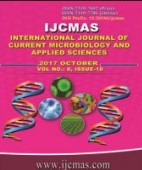


 National Academy of Agricultural Sciences (NAAS)
National Academy of Agricultural Sciences (NAAS)

|
PRINT ISSN : 2319-7692
Online ISSN : 2319-7706 Issues : 12 per year Publisher : Excellent Publishers Email : editorijcmas@gmail.com / submit@ijcmas.com Editor-in-chief: Dr.M.Prakash Index Copernicus ICV 2018: 95.39 NAAS RATING 2020: 5.38 |
Moringa and Papaya are two most popular medicinal plants of Indo-Gangatic planes which are extensively used for their nutritional and medicinal values. Systematic and scientific investigation were carried out to assess the nutritional and medicinal value of these popular plants variety found in Patna and Munger district of Bihar state. Carica papaya Linn. is an unbranched, perennial, unisexual, dioecious, herb, 3-6 meter tall, with crown at the end of trunk. Leaves: long-petioled, palmately - lobed; lobes: again lobed once or twice, with petiole base and milky latex. Male flowers: 2.5-3 cm across white, in axillary panicles of chyme. Corolla of male: gamopetalous. Stamens: 5+5 diplostemonous. Female flower: unisexual, pistillate, actinomorphic, pale-white, with milky latex in solitary or short axillary chymes. Ovaries: 5-carpellary and unilocular, superior; style: short; stigma: 5-lobed. Berry: Cylindrical, ovoid or pyriform, with small seeds. Seeds: black, with an outer sappy and an inner hard testa. Latex is anthelminthic, laxative, digestive, febrifuge and used as tonic. It is also applied externally is ring worm, leprosy and other cutaneous infections. The fresh crushed seeds yield the agly cone of glucotropaeolin benzyl isothiocyante which is a bacteriostatic, bacteriocidal & fungicidal. It is easy to grow is many ecological zone so it can help in achieving the food & nutrition securities. Similarly Moringa is highly nutritive and medicinal plant found in Indo-Gangatic plane. Moringa oleifera is the most widely cultivated species of the genus Moringa, which is the only genus in the family Moringaceae. It is a fast-growing, drought-resistant tree, native to the southern foothills of the Himalayas in northwestern India, and widely cultivated in tropical and subtropical areas where its young seed pods and leaves are used as vegetables. It can also be used for water purification and hand washing, and is sometimes used in herbal medicine. The result reveals that the both the plant studied are highly nutritive and contains phytochemicals having strong antibacterial Properties.
 |
 |
 |
 |
 |